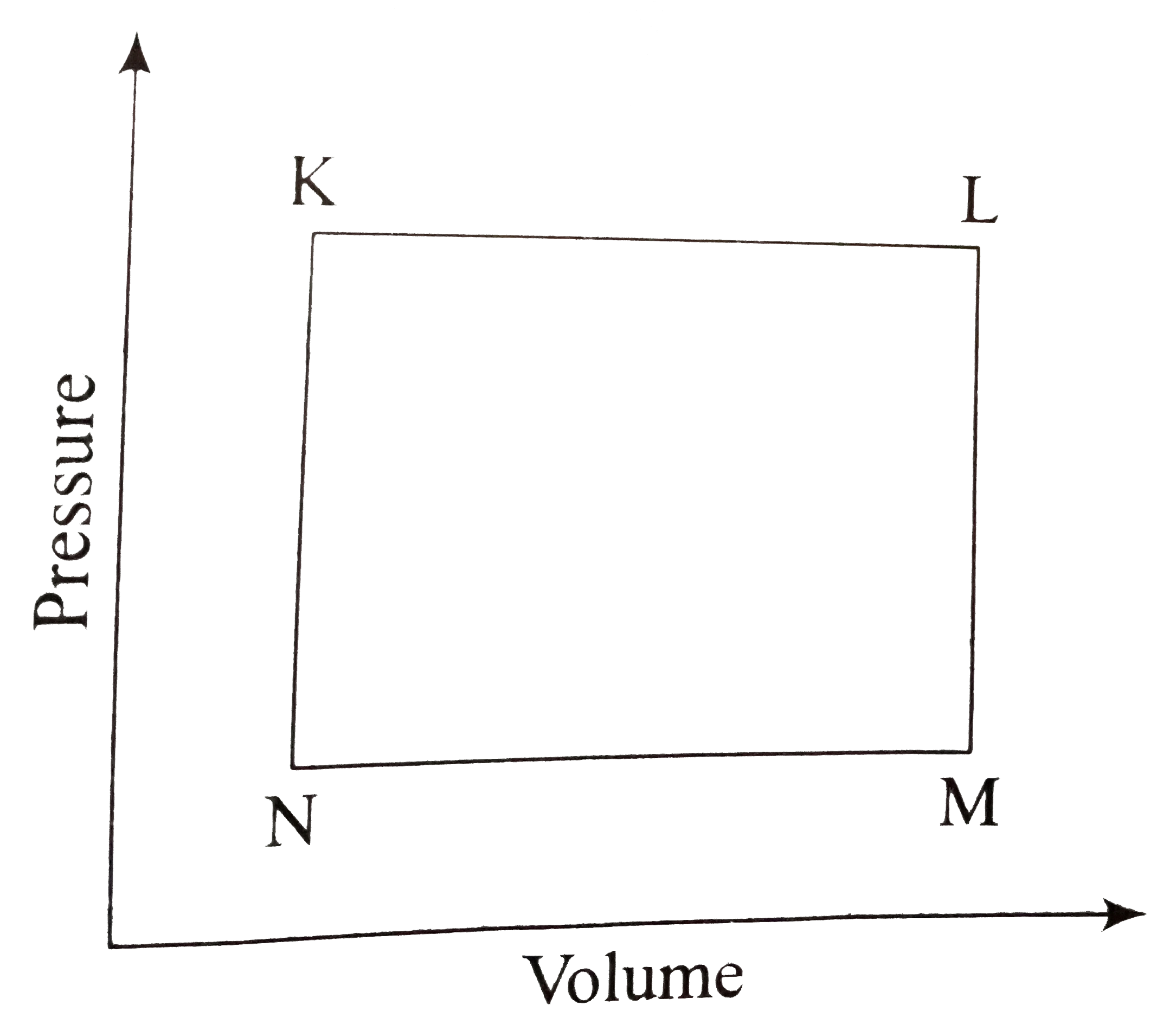Complete Solutions to PART II: CHEMISTRY (Section -2):(Paragraph Type) of chapter JEE ADVANCED of Class 12 book with complete answers and questions
| Class 12 | CHEMISTRY |
| Chapter | JEE ADVANCED |
| JEE ADVANCED | PART II: CHEMISTRY (Section -2):(Paragraph Type) |
| Number Of Questions | 8 |
| Academic Year | 2023-24 |
A fixed mass `m` of a gas is subjected to transformation of state: `K` to L to `M` and back to `K` as shown in the figure.
The succeeding operations that enabel this transformation of state are

View SolutionA fixed mass m of a gas is subjected to transfromation of states from K to L to M and back to K as shown in the figure.

The pair of isochoric processes among the transfromation of states is
View SolutionThe reactions of `CI_(2)` gas with cold-dilute and hot-concentrated NaOH in water give sodium salts of two different oxioacids of chlorine, P and Q, respectively. The `CI_(2)` gas reacts with `SO_(2)` gas, in presence of charocal, to give a product R reacts with white phosphorus to give a compound S. On hydrolysis, S gives an oxoacid of phosphorus.
P and Q, respectively, are the sodium salts of
View SolutionThe reactions of `CI_(2)` gas with cold-dilute and hot-concentrated NaOH in water give sodium salts of two different oxioacids of chlorine, P and Q, respectively. The `CI_(2)` gas reacts with `SO_(2)` gas, in presence of charocal, to give a product R reacts with white phosphorus to give a compound S. On hydrolysis, S gives an oxoacid of phosphorus.
P and Q, respectively, are the sodium salts of
View SolutionAn aqueous solution of a mixture of two inorganic salts, when treated with dilute `HCl`, gave a precipiate (P) and filtrate (Q). The precipitate (P) was found to dissolve in hot water. The filtrate (Q) remained unchanged, when treated with `H_(2)S` in a dilute mineral acid medium. However, it gave a precipitate (R) With `H_(2)S` in an ammoniacal medium. The precipitate R gave a coloured solution (S), when treated with `H_(2)O_(2)` in an aqueous `NaOH` medium.
The precipitate P contains
View SolutionAn aqueous solution of a mixture of two inorganic salts, when treated with dilute `HCl`, gave a precipiate (P) and filtrate (Q). The precipitate (P) was found to dissolve in hot water. The filtrate (Q) remained unchanged, when treated with `H_(2)S` in a dilute mineral acid medium. However, it gave a precipitate (R) With `H_(2)S` in an ammoniacal medium. The precipitate R gave a coloured solution (S), when treated with `H_(2)O_(2)` in an aqueous `NaOH` medium.
The coloured solution S contains
View Solution`P` and `Q` are isomers of dicarboxylic acid `C_(4)H_(4)O_(4)`. Bothdecolorize `Br_(2)//H_(2)O`. On heating, `P` forms the cyclic anhydride. Upon treatment with dilute alkaline `KMnO_(4),P` as well as `Q` could produce one or more than one forms `S,T` and `U`.
 Compounds formed from `P` and `Q` are, respectively
Compounds formed from `P` and `Q` are, respectively
View SolutionP and Q are isomer of dicraboxylic acid `C_(4)H_(4)O_(4)` Both decolourixe `Br_(2)//H_(2)O`. On heating , P forms the cyclic anhydride. Upon treatment with duilute alkaline `KMnO_(4)`. P as well a Q could produce one or more than one from S,T and U.

In the following reaction sequences V and W are respectively

View Solution
PART II: CHEMISTRY (Section -2):(Paragraph Type) questions and complete solutions for chapter JEE ADVANCED of JEE ADVANCED PREVIOUS YEAR of Class 12
All Exercises from JEE ADVANCED Class 12 CHEMISTRY JEE ADVANCED
- CHEMISTRY
- CHEMISTRY SECTION - I : Single correct Answer Type
- CHEMISTRY SECTION - II : Multiple Correct Answer Type
- CHEMISTRY SECTION - III : Integer Answer Type
- CHEMISTRY SECTION - IV : Matric Match Type
- MULTIPLE CHOICE QUESTIONS
- PART II : CHEMISTRY (SECTION -1)
- PART II : CHEMISTRY (SECTION -2)
- PART II : CHEMISTRY (SECTION -3)
- PART II : CHEMISTRY (SECTION 1)
- PART II : CHEMISTRY (SECTION 2)
- PART II : CHEMISTRY (SECTION 3)
- PART II :CHEMISTRY (SECTION 2)
- PART II :CHEMISTRY (SECTION 3)
- PART II: CHEMISTRY (Section -1):(One or more options correct type)
- PART II: CHEMISTRY (Section -2):(Paragraph Type)
- Part II: CHEMISTRY (Section 1)
- Part II: CHEMISTRY (Section 2)
- Part II: CHEMISTRY (Section 3) Paragraph 1
- Part II: CHEMISTRY (Section 3) Paragraph 2
- PART II: CHEMISTRY Section-3:(Matching List Type)
- PART-2 CHEMISTRY SECTION -1 (ONLY ONE OPTION CORRECT TYPE)
- SECTION - 3 (MATCHING LIST TYPE)
- Section - I Single correct Answer Type
- Section - I (Single correct question )
- Section - II (Multiple correct Answer Type Questions)
- Section - II (Multiple correct choice type)
- Section - III (Paragraph type)
- Section - IV (Integer Answer Type)
- SECTION -2 COMPREHENSION TYPE
- SECTION 1
- SECTION 2
- SECTION 3 PARAGRAPH
- SECTION I
- Section I : Single Correct Answer Type
- SECTION II
- Section II : Paragraph Type
- SECTION III
- Section III : Multiple Correct Answer(s) Type
- SECTION- 1 (ONE OR MORE THAN ONE OPTIONS CORRET TYPE)
- Section-1
- Section-2
- Section-3
- SECTION-I (Single Correct Choice Type )
- Section-I (single correct choice type)
- Section-II (Integer type)
- SECTION-II (Multiple Correct Choice Type )
- SECTION-II(Multiple Correct Choice Type )
- Section-III (Paragraph type )
- SECTION-III (Comprehension Type )
- SECTION-III (Matrix-Match Type )
- SECTION-IV (Integer Answer Type )
- Section-IV (integer type)
- Section-IV (Matrix type)
- SECTION-IV(Matrix-Match Type )